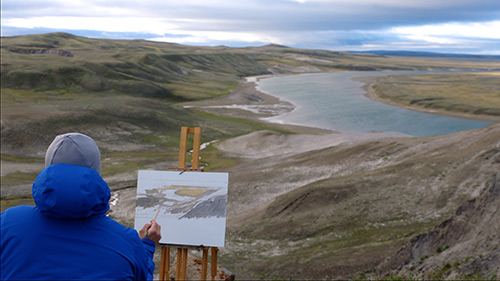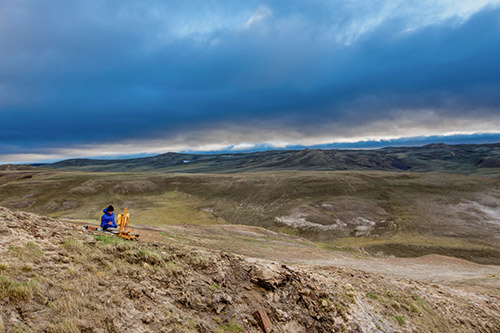– Bob Bahr reporting, Editor PleinAir Today –
Cory Trépanier recently posted a YouTube video of his expedition to Aulavik National Park in the Arctic Circle. He and a couple of friends took canoes down the Thomsen River, “the most northerly navigable canoe route in North America.” We decided to ask him what it takes to go on a nine-week painting expedition across the Canadian Arctic.
Lead Image: Cory Trépanier painting the Thomsen River in Aulavik National Park in Canada. Photo courtesy of Cory Trépanier

The artist said there are countless things that a person needs to do to prepare for such a challenging trip, and then he managed to single out 13 big ones. Trépanier said that there was a lot more to it than remembering to bring your paints. Specifically, he recommended:
- Look at the calendar and start planning far, far ahead. A year or more is a good start.
- Be prepared to spend either a lot of money or spend time cultivating support from companies who can assist in defraying costs through promotional value you can offer (i.e., social media stories, supplying expedition photos, etc.) and clientele who might pre-purchase paintings up front in exchange for first rights to acquire them before the public. Traveling the far north is by its nature rather pricey.
- Make sure you are in the best physical shape you can be before heading into the field. This is not optional; your life depends on it when in the remote wilderness, many miles and days from the nearest hospital. My training included a mix of weight resistance and cardio, to help in carrying canoes, heavy packs, and the like. Training in the winter in an unheated barn in -23 degree Celsius temperatures wasn’t the most fun, but necessary. A simple pulled muscle in the field can jeopardize a huge amount of work that has gone into making the trip happen, and the trip itself. Besides, being fit allows one to focus more on the creative act of painting when, after hours of hiking, the easel is pulled out and the real work begins.
- Practice outdoor skills locally before heading into the wild, and, if you can, bring someone who knows more than you.
- Hire a local guide to access regions beyond your wilderness-travel skill levels. I often have traveled with Inuit guides in remote corners of the Arctic as they have been able provide boat access and gun protection when in polar bear country. Every community has a hunter’s and trapper’s committee and can usually help connect you to someone.
- Bring at least TWO sets of your painting gear — paints, brushes, and panels. You never know when you might have an accident (i.e., dump a canoe) or lose gear at an airport. Replacing art supplies is not an option in the far north during a trip!
- Make lists and more lists for everything you are bringing on the trip, and check them over and over as you pack.
- Don’t paint the first nice view you come across. Instead, take some time to get to know the land, to see the changing effects of the light, which in the far north might be subtler. The sun may not set at all in many places during the summer. Hike around before settling down. Often this can take hours and days, but the result will be more thought-out compositions that reflect this sublime landscape.
- Mosquitoes can be really nasty in some places. Bug jackets are great, but I find looking through the fine mesh to be very annoying. I heavily douse my cap and the underside of the brim with mosquito repellent, then spread it across my face and neck, and keep the rest of my body covered up. I think the mosquitoes up north tend to be quite thirsty, as most of the time they lick the bug dope off and bite me anyway. It’s a small price to pay for spectacular views that no one has ever painted before.
- Keep your painting gear light, and bring fewer colors into the field with you. I recommend this — but I have not been able to pare my own paint selection to much fewer than 15-20 colors.
- LEAVE NO TRACE: Leave nothing behind from your journey but footprints.
- Above all, immerse yourself into the land, take time to soak it in, feel the rhythms of life while out there. The more you know your subject and the greater your passion for it, the more meaning your work will carry for you, and for others that view it.
- There are many challenges in this approach to painting, but the rewards are high for each hard-earned canvas. Connecting with wild places in this manner is humbling as the realization of just how small you are in this vast landscape sets in. And I believe humility leads to better, more meaningful art.

Learn more about Trépanier’s art and painting expeditions here.





There’s long been a movement of outdoor painting in Alaska’s Brook’s Range. Folks have been using alkyds because they dry much faster than oils. Were you painting in oils? Acrylics? On stretched canvas or hard panels? How did you carry wet paintings? Check out the work of Bill Brody at billbrodyartist.com. And think about visiting Nome, Alaska! Happy to accomodate and assist plein air painters in our region if you’ll come paint with me!